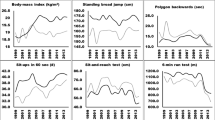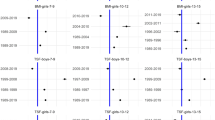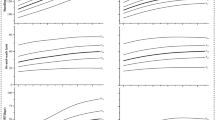Abstract
Objective:
To examine the changes over time in cardiorespiratory fitness and body mass index (BMI) of children.
Design:
Serial cross-sectional, population-based study.
Setting:
Primary schools in Liverpool, UK.
Participants:
A total of 15 621 children (50% boys), representing 74% of eligible 9–11-year olds in the annual school cohorts between 1998/9 and 2003/4, who took part in a 20m multi-stage shuttle run test (20mMST).
Main outcome measures:
Weight, height, BMI (kg/m2) and obesity using the International Obesity Taskforce definition.
Results:
Median (95% confidence interval) 20mMST score (number of runs) fell in boys from 48.9 (47.9–49.9) in 1998/9 to 38.1 (36.8–39.4) in 2003/4, and in girls from 35.8 (35.0–36.6) to 28.1 (27.2–29.1) over the same period. Fitness scores fell across all strata of BMI (P<0.001). Moreover, BMI increased over the same 6-year period even among children in fittest third of 20mMST.
Conclusion:
In a series of uniform cross-sectional assessments of school-aged children, BMI increased whereas cardiorespiratory fitness levels decreased within a 6-year period. Even among lean children, fitness scores decreased. Public health measures to reduce obesity, such as increasing physical activity, may help raise fitness levels among all children – not just the overweight or obese.
This is a preview of subscription content, access via your institution
Access options
Subscribe to this journal
Receive 12 print issues and online access
$259.00 per year
only $21.58 per issue
Buy this article
- Purchase on Springer Link
- Instant access to full article PDF
Prices may be subject to local taxes which are calculated during checkout



Similar content being viewed by others
References
World Health Organization. Obesity: Preventing and Managing the Global Epidemic. World Health Organization: Geneva, 2000.
Prentice AM, Jebb SA . Obesity in Britain: gluttony or sloth? BMJ 1995; 311/7002: 437–439.
Bundred P, Kitchiner D, Buchan I . Prevalence of overweight and obese children between 1989 and 1998: population based series of cross sectional studies. BMJ 2001; 322/7282: 326–328.
Reilly JJ, Dorosty AR . Epidemic of obesity in UK children. Lancet 1999; 354/9193: 1874–1875.
Troiano RP, Briefel RR, Carroll MD, Bialostosky K . Energy and fat intakes of children and adolescents in the United States: data from the national health and nutrition examination surveys. Am J Clin Nutr 2000; 72/5 (Suppl): 1343S–1353S.
Schlicker SA, Borra ST, Regan C . The weight and fitness status of United States children. Nutr Rev 1994; 52/1: 11–17.
Johnson MS, Figueroa-Colon R, Herd SL, Fields DA, Sun M, Hunter GR et al. Aerobic fitness, not energy expenditure, influences subsequent increase in adiposity in black and white children. Pediatrics 2000; 106/4: E50.
Dencker M, Thorsson O, Karlsson MK, Linden C, Eiberg S, Wollmer P et al. Daily physical activity related to body fat in children aged 8–11 years. J Pediatr 2006; 149/1: 38–42.
Grund A, Dilba B, Forberger K, Krause H, Siewers M, Rieckert H et al. Relationships between physical activity, physical fitness, muscle strength and nutritional state in 5- to 11-year-old children. Eur J Appl Physiol 2000; 82/5–6: 425–438.
Wedderkopp N, Froberg K, Hansen HS, Andersen LB . Secular trends in physical fitness and obesity in Danish 9-year-old girls and boys: Odense School Child Study and Danish substudy of the European Youth Heart Study. Scand J Med Sci Sports 2004; 14/3: 150–155.
Dencker M, Thorsson O, Karlsson MK, Linden C, Svensson J, Wollmer P et al. Daily physical activity and its relation to aerobic fitness in children aged 8–11 years. Eur J Appl Physiol 2006; 96/5: 587–592.
Brage S, Wedderkopp N, Ekelund U, Franks PW, Wareham NJ, Andersen LB et al. Features of the metabolic syndrome are associated with objectively measured physical activity and fitness in Danish children: the European Youth Heart Study (EYHS). Diabetes Care 2004; 27/9: 2141–2148.
Ferreira I, Twisk JW, van MW, Kemper HC, Stehouwer CD . Development of fatness, fitness, and lifestyle from adolescence to the age of 36 years: determinants of the metabolic syndrome in young adults: the Amsterdam growth and health longitudinal study. Arch Intern Med 2005; 165/1: 42–48.
LaMonte MJ, Barlow CE, Jurca R, Kampert JB, Church TS, Blair SN . Cardiorespiratory fitness is inversely associated with the incidence of metabolic syndrome: a prospective study of men and women. Circulation 2005; 112/4: 505–512.
Eisenmann JC, Wickel EE, Welk GJ, Blair SN . Relationship between adolescent fitness and fatness and cardiovascular disease risk factors in adulthood: the Aerobics Center Longitudinal Study (ACLS). Am Heart J 2005; 149/1: 46–53.
Andersen LB, Wedderkopp N, Hansen HS, Cooper AR, Froberg K . Biological cardiovascular risk factors cluster in Danish children and adolescents: the European Youth Heart Study. Prev Med 2003; 37/4: 363–367.
Blair SN, Kampert JB, Kohl III HW, Barlow CE, Macera CA, Paffenbarger Jr RS et al. Influences of cardiorespiratory fitness and other precursors on cardiovascular disease and all-cause mortality in men and women. JAMA 1996; 276/3: 205–210.
Taylor S, Hackett A, Stratton G, Lamb L . SportsLinx: improving the health and fitness of Liverpool's youth. Educ Health 2004; 22: 3–7.
Dummer TJ, Gibbon MA, Hackett AF, Stratton G, Taylor SR . Is overweight and obesity in 9–10-year-old children in Liverpool related to deprivation and/or electoral ward when based on school attended? Public Health Nutr 2005; 8/6: 636–641.
EUROFIT. European Test of Physical Fitness. Committee for the Development of Sport, Council of Europe: Rome, 1998.
Baquet G, Twisk JW, Kemper HC, Van PE, Berthoin S . Longitudinal follow-up of fitness during childhood: interaction with physical activity. Am J Hum Biol 2006; 18/1: 51–58.
van Mechelen W, Hlobil H, Kemper HC . Validation of two running tests as estimates of maximal aerobic power in children. Eur J Appl Physiol Occup Physiol 1986; 55/5: 503–506.
Leger LA, Mercier D, Gadoury C, Lambert J . The multistage 20 metre shuttle run test for aerobic fitness. J Sports Sci 1988; 6/2: 93–101.
Office of the Deputy Prime Minister. The English Indices of Deprivation in 2004 (revised). The Stationary Office Limited: London, 2004.
Cole TJ, Bellizzi MC, Flegal KM, Dietz WH . Establishing a standard definition for child overweight and obesity worldwide: international survey. BMJ 2000; 320/7244: 1240–1243.
Brage S, Wedderkopp N, Ekelund U, Franks PW, Wareham NJ, Andersen LB, et al. Features of the metabolic syndrome are associated with objectively measured physical activity and fitness in Danish children: the European Youth Heart Study (EYHS). Diabetes Care 2004; 27/9: 2141–2148.
LaMonte MJ, Barlow CE, Jurca R, Kampert JB, Church TS, Blair SN . Cardiorespiratory fitness is inversely associated with the incidence of metabolic syndrome: a prospective study of men and women. Circulation 2005; 112/4: 505–512.
Andersen LB, Wedderkopp N, Hansen HS, Cooper AR, Froberg K . Biological cardiovascular risk factors cluster in Danish children and adolescents: the European Youth Heart Study. Prev Med 2003; 37/4: 363–367.
Blair SN, Kampert JB, Kohl III HW, Barlow CE, Macera CA, Paffenbarger Jr RS et al. Influences of cardiorespiratory fitness and other precursors on cardiovascular disease and all-cause mortality in men and women. JAMA 1996; 276/3: 205–210.
Wedderkopp N, Froberg K, Hansen HS, Andersen LB . Secular trends in physical fitness and obesity in Danish 9-year-old girls and boys: Odense School Child Study and Danish substudy of the European Youth Heart Study. Scand J Med Sci Sports 2004; 14/3: 150–155.
Tomkinson GR, Leger LA, Olds TS, Cazorla G . Secular trends in the performance of children and adolescents (1980–2000): an analysis of 55 studies of the 20 m shuttle run test in 11 countries. Sports Med 2003; 33/4: 285–300.
Dencker M, Thorsson O, Karlsson MK, Linden C, Eiberg S, Wollmer P et al. Daily physical activity related to body fat in children aged 8–11 years. J Pediatr 2006; 149/1: 38–42.
Grund A, Dilba B, Forberger K, Krause H, Siewers M, Rieckert H et al. Relationships between physical activity, physical fitness, muscle strength and nutritional state in 5- to 11-year-old children. Eur J Appl Physiol 2000; 82/5–6: 425–438.
Wedderkopp N, Froberg K, Hansen HS, Andersen LB . Secular trends in physical fitness and obesity in Danish 9-year-old girls and boys: Odense School Child Study and Danish substudy of the European Youth Heart Study. Scand J Med Sci Sports 2004; 14/3: 150–155.
Deforche B, Lefevre J, De I B, Hills AP, Duquet W, Bouckaert J . Physical fitness and physical activity in obese and nonobese Flemish youth. Obes Res 2003; 11/3: 434–441.
Dencker M, Thorsson O, Karlsson MK, Linden C, Svensson J, Wollmer P et al. Daily physical activity and its relation to aerobic fitness in children aged 8–11 years. Eur J Appl Physiol 2006; 96/5: 587–592.
Durnin JVGA . Physical activity levels – past and present. In: Norgan NG (ed) Physical Activity and Health. Cambridge University Press: Cambridge, 1992. pp 20–27.
Prentice AM, Jebb SA . Obesity in Britain: gluttony or sloth? BMJ 1995; 311/7002: 437–439.
Dencker M, Thorsson O, Karlsson MK, Linden C, Eiberg S, Wollmer P et al. Daily physical activity related to body fat in children aged 8–11 years. J Pediatr 2006; 149/1: 38–42.
Dencker M, Thorsson O, Karlsson MK, Linden C, Svensson J, Wollmer P et al. Daily physical activity and its relation to aerobic fitness in children aged 8–11 years. Eur J Appl Physiol 2006; 96/5: 587–592.
Caspersen CJ, Powell KE, Christenson GM . Physical activity, exercise, and physical fitness: definitions and distinctions for health-related research. Public Health Rep 1985; 100/2: 126–131.
American College of Sports Medicine Position Stand. The recommended quantity and quality of exercise for developing and maintaining cardiorespiratory and muscular fitness, and flexibility in healthy adults. Med Sci Sports Exerc 1998; 30/6: 975–991.
Haskell WL, Leon AS, Caspersen CJ, Froelicher VF, Hagberg JM, Harlan W et al. Cardiovascular benefits and assessment of physical activity and physical fitness in adults. Med Sci Sports Exerc 1992; 24/6 (Suppl): S201–S220.
Pate RR, Dowda M, Ross JG . Associations between physical activity and physical fitness in American children. Am J Dis Child 1990; 144/10: 1123–1129.
Ruiz JR, Rizzo NS, Hurtig-Wennlof A, Ortega FB, Warnberg J, Sjostrom M . Relations of total physical activity and intensity to fitness and fatness in children: the European Youth Heart Study. Am J Clin Nutr 2006; 84/2: 299–303.
Ruiz JR, Rizzo NS, Hurtig-Wennlof A, Ortega FB, Warnberg J, Sjostrom M . Relations of total physical activity and intensity to fitness and fatness in children: the European Youth Heart Study. Am J Clin Nutr 2006; 84/2: 299–303.
Goudas M, Biddle S, Fox K . Perceived locus of causality, goal orientations, and perceived competence in school physical education classes. Br J Educ Psychol 1994; 64 (Part 3): 453–463.
Dummer TJ, Gibbon MA, Hackett AF, Stratton G, Taylor SR . Is overweight and obesity in 9–10-year-old children in Liverpool related to deprivation and/or electoral ward when based on school attended? Public Health Nutr 2005; 8/6: 636–641.
Eriksson J, Forsen T, Osmond C, Barker D . Obesity from cradle to grave. Int J Obes Relat Metab Disord 2003; 27/6: 722–727.
Department of Health. Measuring Childhood Obesity: Guidance to Primary Care Trusts. Department of Health: London, 2006.
Cole TJ, Bellizzi MC, Flegal KM, Dietz WH . Establishing a standard definition for child overweight and obesity worldwide: international survey. BMJ 2000; 320/7244: 1240–1243.
Cole TJ, Bellizzi MC, Flegal KM, Dietz WH . Establishing a standard definition for child overweight and obesity worldwide: international survey. BMJ 2000; 320/7244: 1240–1243.
Acknowledgements
We thank Liz Lamb for managing the programme and Glen Groves, Vicci Allan and Jenny for collecting the data. The SportsLinx project was funded by Liverpool City Council, Liverpool John Moores University, The Children's Fund and the Neighbourhood Renewal Fund.
Contributors: GS and AFH designed the Sportslinx project. GS noticed a downward trend in cardiorespiratory fitness and upward trend in BMI after the initial analysis and interpretation of the data and led the initial writing of the manuscript. SRT and LMB managed the data and contributed to the manuscript. IEB performed the statistical analysis, interpreted the findings and led the second draft of the manuscript. DC contributed to statistical analysis, interpretation and subsequent drafts of the manuscript. GS is the guarantor of the paper.
Ethics: Ethics approval has been given by Liverpool John Moores University ethics committee and the Royal Liverpool Children's Hospital Ethics Committee.
Author information
Authors and Affiliations
Corresponding author
Additional information
Conflict of interest statement
We declare that we have no conflict of interest.
Rights and permissions
About this article
Cite this article
Stratton, G., Canoy, D., Boddy, L. et al. Cardiorespiratory fitness and body mass index of 9–11-year-old English children: a serial cross-sectional study from 1998 to 2004. Int J Obes 31, 1172–1178 (2007). https://doi.org/10.1038/sj.ijo.0803562
Received:
Revised:
Accepted:
Published:
Issue Date:
DOI: https://doi.org/10.1038/sj.ijo.0803562
Keywords
This article is cited by
-
Secular trends in physical fitness of Slovenian boys and girls aged 7 to 15 years from 1989 to 2019: a population-based study
Scientific Reports (2022)
-
Secular trends in health-related physical fitness among 11–14-year-old Croatian children and adolescents from 1999 to 2014
Scientific Reports (2021)
-
A Method by Which to Assess the Scalability of Field-Based Fitness Tests of Cardiorespiratory Fitness Among Schoolchildren
Sports Medicine (2016)
-
Six-year changes in body mass index and cardiorespiratory fitness of English schoolchildren from an affluent area
International Journal of Obesity (2015)
-
Promoting healthy weight in primary school children through physical activity and nutrition education: a pragmatic evaluation of the CHANGE! randomised intervention study
BMC Public Health (2013)



